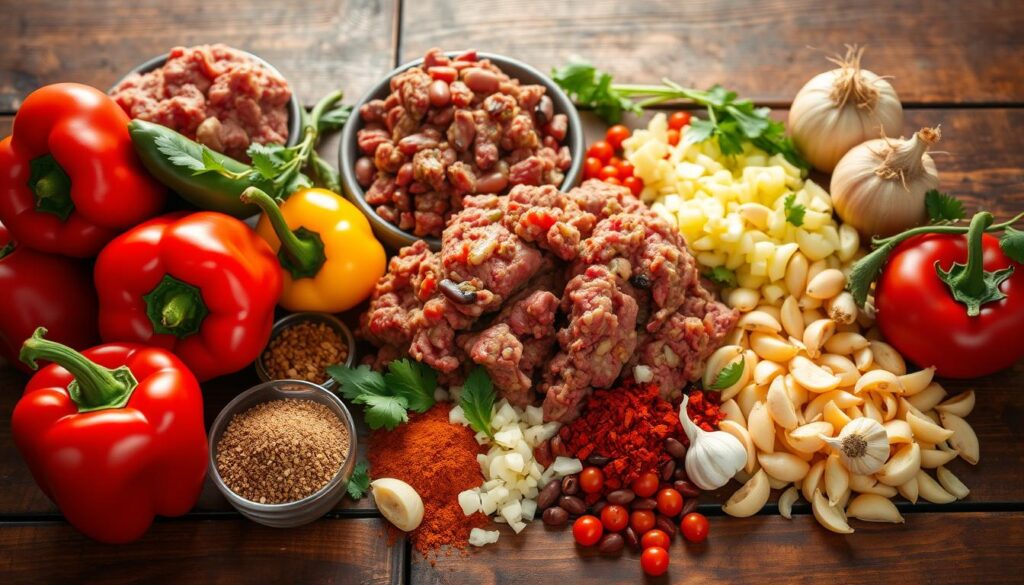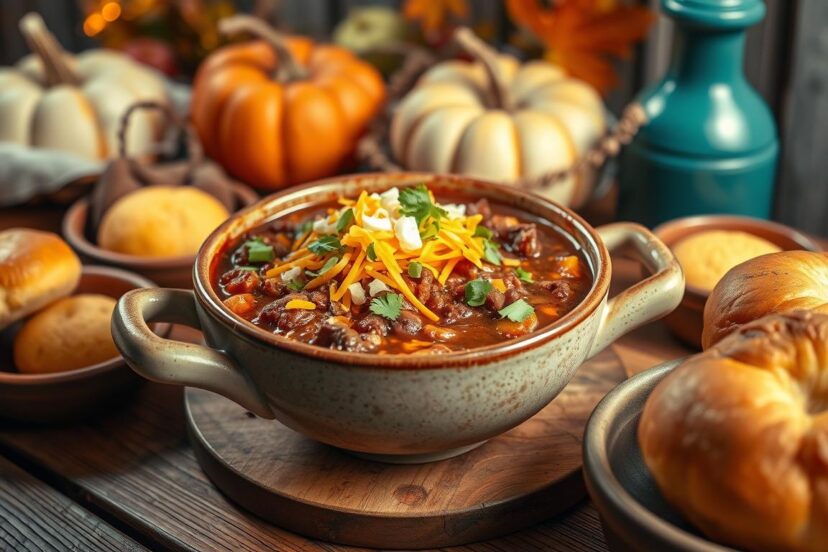Hearty Beef Chili Recipes for Cozy Evenings
Winter nights call for something special. My love for homemade beef chili always saves the day. A steaming pot of beef chili turns any evening into a cozy, comforting moment.
Beef chili is more than a meal; it’s a tradition that brings families together. Each recipe has its own story of flavor, warmth, and rich ingredients. Whether you’re a chili lover or new to it, these recipes will spark your kitchen adventures.
Beef chili comes in many styles, from classic Texas to innovative twists. I’ve honed techniques to make this dish a gourmet delight. It warms both body and soul.
In the next sections, I’ll share my top homemade beef chili recipes and tips. You’ll learn how to make this comfort food a gourmet experience. Get ready for a journey of robust flavors and hearty satisfaction.
Introduction to Beef Chili
Chili is more than a meal; it’s a warm experience for body and soul. My love for traditional beef chili connects me to a rich American tradition. It celebrates bold flavors and hearty comfort.
What Makes Beef Chili Special?
Beef chili is special because of its versatility and rich taste. It combines tender beef, aromatic spices, and complex seasonings. This mix creates a dish that’s both satisfying and comforting.
What makes traditional beef chili unique is how it turns simple ingredients into a memorable meal.
- Rich, layered flavor combinations
- Adaptable to different taste preferences
- Nutritionally dense and filling
- Perfect for sharing with family and friends
The History Behind Chili
Chili’s history starts in the Southwest, where Mexican and Texan cooking traditions came together. It was a dish for the working class, made with what was available. Cowboys, settlers, and communities loved it for feeding many with little.
Why I Love Making Beef Chili
I love making traditional beef chili for its simplicity and depth. It’s more than a meal; it’s an experience. The slow simmering brings out the flavors, turning simple ingredients into a masterpiece that brings people together.
Choosing the Right Beef for Chili
Choosing the right beef is key to making the best beef chili. The meat you pick can turn a good chili into a memorable dish.
Not all beef cuts are the same for chili. I’ll show you the best options for the perfect beef chili.
Cuts of Beef to Consider
- Ground Beef: Affordable and quick-cooking
- Chuck Roast: Rich flavor and tender texture
- Sirloin: Lean and meaty option
For the best chili, use chuck roast. It has enough fat for a rich flavor and stays tender while slow cooking.
Grass-Fed vs. Grain-Fed Beef
| Beef Type | Flavor Profile | Nutritional Value |
|---|---|---|
| Grass-Fed | Leaner, slightly gamey taste | Higher omega-3 fatty acids |
| Grain-Fed | More marbled, mild flavor | More consistent meat texture |
Try both grass-fed and grain-fed beef for your chili. Grass-fed beef gives a unique taste that can make your chili stand out.
Remember, great chili isn’t just about the beef. It’s also about how you prepare and season it. Pick a cut that fits your taste and cooking style.
Essential Ingredients for Beef Chili
Making the perfect homemade beef chili needs careful picking of ingredients. These ingredients must blend to create deep, rich flavors. Every traditional beef chili has its own mix of parts that turn simple ingredients into a memorable dish.

Beans: The Great Chili Debate
Beans can spark a big debate in chili making. Some say no beans, while others think they’re key. I say it’s up to you – here are some bean options:
- Kidney beans for traditional texture
- Black beans for added protein
- Pinto beans for creamy consistency
Spices That Transform Flavor
Spices are the heart of any great homemade beef chili. My top spice picks are:
- Chili powder for foundational heat
- Cumin for earthy depth
- Smoked paprika for subtle smokiness
- Cayenne pepper for optional kick
Vegetables: Adding Depth and Nutrition
Vegetables do more than just fill space – they boost flavor in traditional beef chili. My go-to veggies are:
- Diced onions for sweetness
- Bell peppers for crunch
- Roasted green chilies for complexity
By mixing these ingredients, you get a beef chili that’s both filling and healthy.
Preparation Techniques for Perfect Chili
Making an award-winning beef chili is more than just mixing ingredients. It’s about mastering certain techniques to make it unforgettable.
To create a standout chili, you need to know the key preparation methods. These methods make the cooking process better.
Mastering Beef Browning Techniques
Browning beef is key for rich flavors. Here are my best tips for browning meat perfectly:
- Use a heavy-bottomed pan for even heat distribution
- Pat meat dry before cooking to ensure proper browning
- Cook in batches to prevent overcrowding
- Allow meat to develop a golden-brown crust before stirring
Ingredient Layering Strategy
Creating a great chili is all about adding ingredients at the right time. Different ingredients release flavors at different rates. So, timing is crucial.
| Ingredient Group | Adding Time | Purpose |
|---|---|---|
| Aromatics (Onions, Garlic) | Early Stage | Build foundational flavor |
| Spices | Mid Cooking | Develop depth and complexity |
| Fresh Herbs | End of Cooking | Preserve bright, fresh notes |
By using these techniques, you’ll make a delicious, award-winning beef chili. It will impress anyone.
Classic Beef Chili Recipe
Making the best beef chili is an art. It mixes simple ingredients with careful steps. My favorite recipe has been perfected over years. It’s a hearty, delicious meal that warms you up.
Essential Ingredients for Authentic Beef Chili
First, gather these key ingredients for amazing beef chili:
- 2 pounds ground beef (80/20 blend)
- 2 large onions, diced
- 3 garlic cloves, minced
- 2 cans of kidney beans
- 2 cans of diced tomatoes
- Chili powder, cumin, and paprika
Step-by-Step Cooking Instructions
Mastering beef chili needs focus. Start by browning the ground beef in a large pot over medium-high heat. Break the meat into small chunks for even cooking and flavor.
- Brown beef until no pink remains
- Add onions and garlic, sauté for 3-4 minutes
- Incorporate spices and stir thoroughly
- Add tomatoes and beans
- Simmer on low heat for 1-2 hours
Customization Tips for Perfect Beef Chili
Beef chili is all about trying new things. Add different peppers, change spice levels, or swap beans for your own twist. For a smoky flavor, add chipotle pepper or smoked paprika.
Great beef chili comes from layering flavors and letting them mix. Don’t rush it. Patience makes it the best.
Spicy Variations of Beef Chili
Turning a classic beef chili into a spicy masterpiece is all about the right spices and peppers. I love making dishes that pack a punch. Heat is not just about adding fire; it’s an art.

Adding Heat: Favorite Spices
For a spicy beef chili, mix spices carefully. This way, you boost the heat without losing the meat’s flavor. My top picks are:
- Cayenne pepper for intense heat
- Chipotle powder for smoky warmth
- Red pepper flakes for an instant kick
- Ground cumin for depth
Incorporating Other Peppers
The key to a great spicy beef chili is choosing the right peppers. Each pepper adds its own heat and taste.
| Pepper Type | Heat Level (Scoville) | Flavor Profile |
|---|---|---|
| Poblano | 1,000-1,500 | Mild, slightly earthy |
| Jalapeño | 2,500-8,000 | Sharp, bright heat |
| Serrano | 10,000-23,000 | Intense, quick burn |
| Habanero | 100,000-350,000 | Extreme heat, fruity undertones |
Tip for your spicy beef chili: Begin with milder peppers and add more heat as you like. Remove seeds to control spice. Always taste as you go!
Healthier Versions of Beef Chili
Making a nutritious hearty beef chili doesn’t mean losing flavor. By choosing smart ingredients, you can make this classic dish healthier. It will still taste great and warm you up.
I started making healthier hearty beef chili by looking for protein alternatives. Ground turkey is a great choice. It has less fat than regular beef but still tastes good.
Lean Ground Beef Alternatives
- Ground turkey (93% lean)
- Plant-based meat substitutes
- Lean ground chicken
- Textured vegetable protein
When picking protein for your chili, choose low-fat options. Plant-based alternatives offer protein and cut calories.
Low-Sodium and Healthy Ingredient Swaps
- Replace salt with herbs and spices
- Use low-sodium beans
- Add extra vegetables for bulk
- Choose no-salt-added tomato products
To make chili healthier, think outside the box with ingredients. Adding more veggies like bell peppers and carrots boosts fiber. It also means you need less salt.
With these easy changes, you can enjoy a hearty beef chili that’s good for you. It will still satisfy your taste buds.
Pairing Suggestions for Beef Chili
Creating the perfect homemade beef chili experience is more than just the dish. The right sides and drinks can make a meal unforgettable. I’ve found some great pairing options that bring out the rich flavors of homemade beef chili.
Best Sides to Serve with Chili
Choosing the right sides can make your homemade beef chili meal even better. Here are some popular choices:
- Cornbread with honey butter
- Crispy sweet potato fries
- Creamy coleslaw
- Jalapeño cheese biscuits
- Cilantro-lime rice
Perfect Beverage Pairings
Finding the right drink can really enhance your homemade beef chili. Here are some drinks that pair well:
| Beverage Type | Best Pairing Reasons |
|---|---|
| Craft Beer | Cuts through rich chili flavors |
| Margarita | Complements spicy chili notes |
| Iced Tea | Refreshing non-alcoholic option |
| Red Zinfandel | Matches robust beef flavor |
Remember, the best pairings are a matter of personal taste. Feel free to try different sides and drinks to find your favorite homemade beef chili combo!
Storing and Reheating Leftover Chili
Keeping your slow cooker beef chili fresh is key. I’ve found that quick cooling and airtight storage are crucial. This way, your chili stays delicious for days.
Best Practices for Storage
Refrigerate your chili within two hours of cooking. Use shallow containers to cool it faster and prevent bacteria. Glass or plastic containers with tight lids are best.
You can store it in the fridge for 3-4 days. This makes it perfect for meal prep.
How to Reheat Without Losing Flavor
Reheating chili needs gentle heat to keep its flavor and texture. I like using the stovetop, heating it slowly over medium-low heat. Stir occasionally.
If you’re in a rush, the microwave is okay. Use a microwave-safe dish and stir every 30 seconds. For slow cooker chili, reheat it in the slow cooker on low. This keeps the flavor and texture just right.
Pro tip: If your chili is too thick after chilling, add some water or broth. This trick keeps it tasting great and prevents it from drying out.



